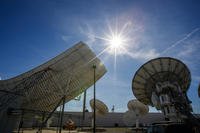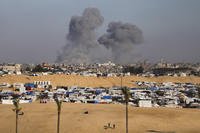Israel pioneered the art of using drones in combat. So it's a little surprising that the robotic spy planes got so little play in the accounts of the Sabras' recent conflict with Hezbollah. Flight International tries to fix that, with a detail-rich report card on how the Israeli unmanned air force performed.
With the outbreak of hostilities on 12 July, the air force focused its efforts on suppressing Hezbollah's launch capabilities, cutting off its resupply routes from Syria and destroying the fully Hezbollah-controlled quarter of Beirut. UAVs [unmanned aerial vehicles] served as the eyes and ears for these operations, launching from bases in central and northern Israel and also from landing strips usually employed by crop-spraying aircraft after rockets landed near air force facilities in northern Israel...
Israel Aircraft Industries (IAI) sources say the air force's recently delivered Heron 1 UAVs performed "beyond expectation" during the war, and demonstrated the full extent of the type's endurance while flying day and night missions over enemy territory. Heron air vehicles flew hundreds of sorties and amassed thousands of flight hours carrying 250kg (550lb) payloads comprising a variety of sensors. IAI says the medium-altitiude, long-endurance vehicle provided unmatched reliability, with no mission aborts.
Air force sources say the Heron was used mainly for electronic-intelligence missions over Lebanon. The service's IAI Searcher 2s also flew thousands of mission hours with excellent reliability, IAI says.
The air force also accumulated 15,000 flight hours with its Elbit Systems Hermes 450 UAVs in the conflict, flying round-the-clock missions with the type, which had previously recorded an annual usage rate of 10,000h. Three Hermes 450s crashed during the war: two as a result of technical problems and one due to operator error, with air force Lockheed Martin F-16 fighters having subsequently bombed the wreckage. Lebanese sources quoted in the Arab language press say the Hermes 450 was also used for precision attack missions. The Israeli air force declines to comment...
Sources say Hezbollah was ready for the UAVs and in many cases camouflaged rocket launchers, particularly with the use of special "carpets" that absorbed the sun's heat and radiated it at night to affect the efficiency of Israeli thermal sensors. "In many cases we had to detect the launch flash to determine the location of the launcher," says an air force source.
As well as highlighting the need for improved sensors, the campaign has prompted the Israeli air and defence forces to work together on an operating concept that will allow their UAVs to combine to provide a more detailed picture of an area of interest. "We will need improved optical payloads for day and night and a joint operational pattern between the Hermes 450 and the Skylark mini UAV," says one source. Another lesson learned is the need to equip tactical UAVs with countermeasures similar to those carried by manned aircraft.







